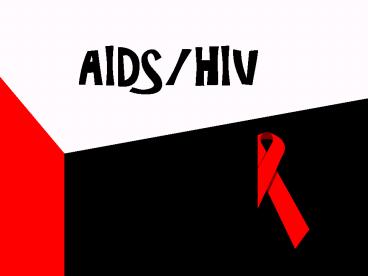AIDS/HIV - PowerPoint PPT Presentation
1 / 15
Title:
AIDS/HIV
Description:
AIDS/HIV HIV/AIDS Infection: How do you get it? Unprotected sexual intercourse - anal,vaginal, oral Sharing drug needles and syringes Sharing unsanitary piercing ... – PowerPoint PPT presentation
Number of Views:47
Avg rating:3.0/5.0
Title: AIDS/HIV
1
AIDS/HIV
2
HIV/AIDS Infection How do you get it?
- Unprotected sexual intercourse - anal,vaginal,
oral - Sharing drug needles and syringes
- Sharing unsanitary piercing instruments
- From mother to child
- Blood contact
3
HIV is NOT spread via
- Kissing
- Biting
- Blood sucking insects
4
The Statistics say
- Two Americans age 13-21 years are infected with
HIV every hour of every day (Youth and HIV/AIDS
An American Agenda Report 1996) - 10.3 million people aged 15-24 are living with
HIV/AIDS (Fact sheet on prevention HIV/AIDS among
young people by UNAIDS 1999) - 900,000 North Americans are currently infected
with HIV, with 40,000 new infections yearly
(Center for Disease Control and Prevention, 2001) - Women aged 15-49 represent 43 of all new HIV
infections (The Joint United Nations Division on
AIDS)
5
The College Facts
- One in every 500 American college students is
infected with HIV - The CDC estimates the rate of HIV infection in
the general American population at one in 250 - 4 factors that put college students at increasing
risk peer pressure, lack of maturity, increase
in alcohol/drug use, and growing incidence of
date rape
6
What is HIV?
- Human Immunodeficiency Virus. HIV attacks the
immune system - the part of our body that
protects us from infections and illnesses. It
takes about 3 - 6 months for HIV to appear after
infection.
7
What is AIDS?
- AIDS, the Acquired Immune Deficiency, is a
disease caused by HIV. Once infected with HIV,
it typically takes 10 years to develop AIDS
(although in some, this time may be shorter).
People with AIDS cannot fight common diseases,
and therefore become very ill and die. A person
can be infected with HIV and not have AIDS.
8
Who can get HIV?
- ANYONEMan, Woman, Gay, Straight, Christian, Jew,
Black, White, Asian, Latino, Canadian, Young, Old
ANYONE. - That includes you!
9
Can I tell if my partner is sick?
- People who are infected can have the virus in
their body for years before getting sick. During
this time, they look and feel healthy. If they
have sex with anyone, there is the chance that
they will spread the virus to their sex partner.
10
The AIDS Quilt
- The AIDS quilt travels on display to promote
public awareness of acquired immune deficiency
syndrome (AIDS). The quilt project initiated in
1986 by the NAMES Project organization, consists
of thousands of panels. Each panel is
individually designed and is dedicated to the
memory of someone who has died of AIDS.
11
For information about the NAMES Project
- Archive Project 415.882.5569 x346 or email
archive_at_aidsquilt.org - Community-Based Academic Programs 415.882.5569
x314 or email display_at_aidsquilt.org - World AIDS Day Display Program 415.882.5569 x323
or email wad_at_aidsquilt.org
12
Infection Rates Cumulative Cases by
Age (According to the CDC June 2001
13
Cumulative Cases by Race/Ethnicity
14
For More Information about AIDS/HIV
- CDC National AIDS Hotline
- 1-800-342-AIDS (2437)
- Spanish 1-800-344-7432
- Deaf 1-800-243-7889
- www.cdc.gov/hiv/stats.html
15
About the creator of this bulletin board
Christa Sandelier is currently serving as the
Area Coordinator for the Jester Center at the
University of Texas in Austin. She received her
Bachelor's degree at Delaware Valley College in
PA and her Master's at Shippensburg University in
PA. After spending time as a Residence Director
and working on her Master's at Shippensburg
University she worked as an Area Coordinator at
Colorado State University. Christa has written a
number of works for Reslife.Net and also
co-authored a chapter for ACUHO-I's Pursuing a
Career in Housing. She has also served as a
panelist for an audio conference for Paperclip
Communications on supervision. Christa is an
active member in ACPA, serving on the Placement
Center Committee. She is looking to begin her
doctorate in the near future.































